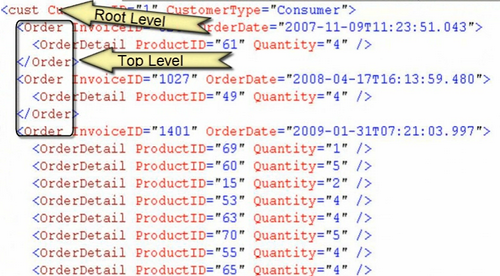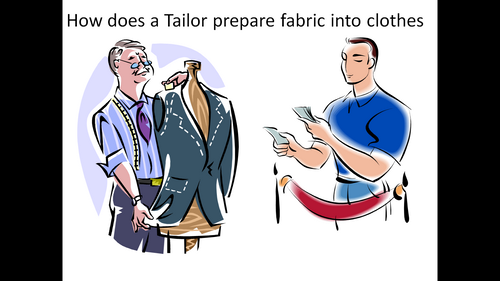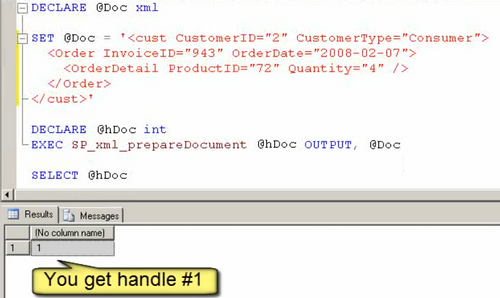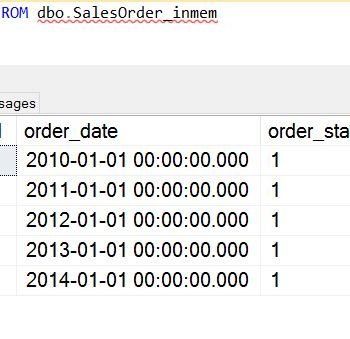Answer simple quiz at the end of the blog post and –
Every day one winner from India will get Joes 2 Pros Volume 5.
Every day one winner from United States will get Joes 2 Pros Volume 5.
Preparing XML in Memory
If you want to take XML data and create a result set in SQL Server, you must first store the XML in memory. The process of preparing XML in SQL includes storing the XML in memory and processing the XML so that all the data and metadata is ready and available for you to query.
Recall that element levels in your XML document appear in the same order that tables appear in your SELECT list and are named according to any aliases you may have chosen (e.g., cust, Order, OrderDetail).

A related query from the figure below helps to illustrate our root element (cust) having a top-level element (Order) and a child-level element (OrderDetail). There is a 1:Many (One-to-Many) relationship between the root node and the lower elements.

Copy your XML result into a brand new query window and enclose it in single quotes (see figure below). Let’s briefly digress for another comparison which may be helpful for our next step. Preparing to have your XML document shredded by SQL Server is a bit like the steps you take when having your tailor create a custom garment for you. One of my students recently underwent this process. Her favorite tailor, Kim, had the design for a poncho she liked. The tailor sent my student to the fabric store to select the particular fabric and trim she wanted for her poncho.When she brought the fabric and trim to Kim’s shop, Kim took the fabric, wrote up an order slip, and then gave my student a claim ticket and said her poncho would be done in a week. You stored your garment at the tailor and when you want to use it you must show your claim ticket.

This tailor runs a small neighborhood shop but is always very busy due to the high quality of her work. While Kim could eventually have located the order without the benefit of the claim ticket, my conscientious student made very sure to bring her ticket when she returned the following week. She submitted her claim ticket and in exchange she was handed her lovely new hand-made garment.

Much the same way, when you send an XML document to be tailored into memory, SQL Server gives you a claim number (called a handle) which you need later when referring to that document. We will send our XML document into memory and in exchange we will get back the handle in the form of an integer. To send our document into memory, we first need to declare an XML variable. In order for this variable to contain our XML document, we will set it equal to our XML.

The @Doc variable’s data type is XML. Next we will declare the variable @hDoc, which we know will be an integer because it is the variable which will act as our document handle (i.e., our “claim ticket”). We will also use sp_XML_PrepareDocument, a system-supplied stored procedure which reads our XML document (@Doc), parses it, and makes it available for SQL’s use.
![]()
When we send our XML to SQL Server’s internal cache, we will receive a number which functions as our “claim ticket.” Run all of the code together, including a SELECT statement to display the document handle (i.e., our “claim ticket” which SQL Server provides in exchange for the XML document). Run all of the code together and make note of the handle number, which is 1.

Be sure to run this code only once, otherwise you will create multiple handles and instances of your XML document. Avoid accidentally creating unneeded instances of your document and handle.

Using the OpenXML Function
We just sent our prepared XML into the SQL Server’s internal cache so that we may pull out the data we want. The OpenXML function provides a rowset view of your XML data. It works with the in-memory copy of the XML document you’ve stored and provides a view of the data, no longer formatted as XML but with all its parts separated into a large grid. This allows you to query just the data that you need.
We know the key to accessing the stored XML document is the document handle (like a claim ticket). The first argument needed by the OpenXML function is this value expressed as an integer. The second argument is the rowpattern hint for the data we wish to see.
After declaring an integer variable and setting it equal to 1 (i.e., the value of our document handle, from 2 figures ago), we can use a SELECT statement to query the result set of the OpenXML function. The variable @iNum is the first parameter. The second parameter ‘/cust/Order/OrderDetail’ specifies that we wish to see data for the OrderDetail element level.

Rowpattern
Since XML can have root tags, top level tags, and many levels of child tags, rowpatterns are needed to figure out which level represent your row data. A rowpattern is an XPath pattern telling your query where to look for the data that you want to see in your result.
In our current example, the rowpattern hint (‘/cust/Order/OrderDetail’) narrows our query to the attributes found at the OrderDetail element level (see figure above). While the surrounding data isn’t immediately interpretable, we can see the text for the ProductID attribute shows a 72, and the text for the Quantity attribute shows a 4 (see lower right corner of the figure above).
Shredding One Level
Adding the WITH clause to our existing query allows us to pick just the values we wish to see. Our query specifies that we are still interested in data from the OrderDetail element level (see figure below). Our WITH clause lists the field names we want (ProductID, Quantity) from this element level and that these values should be expressed as integer data. In other words, ProductID and Quantity are both integers. The WITH clause allows us to shred data at a single element level.

Note: If you want to setup the sample JProCo database on your system you can watch this video. For this post you will want to run the SQLInteropChapter1.0Setup.sql script from Volume 5.
Question 34
The sp_XML_PrepareDocument stored procedure requires a parameter that is an XML data type. What is the output parameter for?
- The handle as an INT
- The handle as an XML
- The handle as a Varchar
Rules:
Please leave your answer in comment section below with correct option, explanation and your country of resident.
Every day one winner will be announced from United States.
Every day one winner will be announced from India.
A valid answer must contain country of residence of answerer.
Please check my facebook page for winners name and correct answer.
Every day one winner from India will get Joes 2 Pros Volume 5.
Every day one winner from United States will get Joes 2 Pros Volume 5.
The contest is open till next blog post shows up at which is next day GTM+2.5.
Reference: Pinal Dave (https://blog.sqlauthority.com)






36 Comments. Leave new
Option 1 is the correct answer.
Uday
USA
Correct answer is No. 1, because we need two variables: the XML variable where we’ll send an XML document to be tailored into memory and an INT variable which will be the the handle to acces that tailored data in memory (as a claim ticket).
Rene Castro
El Salvador
the correct answer is option 1 i.e.
1. The handle as an INT
India
Correct ans is No. 1 “The handle as an INT”
DECALRE @Data NVARCHAR(MAX)
DECLARE @iDocument INTEGER
EXEC SP_XML_PREPAREDOCUMENT @iDocument OUTPUT,@Data
INSERT INTO @TableVariable SELECT * FROM OPENXML (@iDocument, ‘/XmlDocument/XmlValue’,2)
WITH
(
ID INTEGER,
Marks INTEGER
)
EXEC SP_XML_REMOVEDOCUMENT @iDocument
Amit Malhtora
India
Hi,
Correct ans is 1,
The handle as an INT
xml out put handler must be int.
I am from India.
The handle as an INT
USA
Love your post
Correct Answer is # 1.
1.The handle as an INT
Because, If you want to take XML data and create a result set in SQL Server, you must first store the XML in memory and processing the XML so that all the data and metadata is ready and available to query. For this we have to declare two variables.
An XML variable for SQL – To store XML Document
An integar variable for you – To handle claim number (called Handle)
Gopalakrishnan Arthanarisamy
Unisys, Bangalore, India
Correct Answer is Option#1
Explanation:
Parameter Passed in SP_XML_PREPARESTATEMENT are handle as int(which is claim ticket for our order) and a XML DataType(which is orderslip according to which Tailor(SqlserverMemory) will prepare the cloth).
Vishal Patwardhan
Indore(India)
Correct answer is option 1
1. The handle as an INT
sp_XML_PrepareDocument, a system-supplied stored procedure which reads our XML document, parses it, and makes it available for SQL’s use.
When we send our XML to SQL Server’s internal cache, we will receive a number which functions as our “claim ticket” which we need later when referring to that document.
Country – INDIA (Gujarat)
Correct answer is “The handle as an INT”
Country: INDIA
The correct option is 1,
The handle as an INT
(Sale, Nigeria)
Correct answer is option #1.
1.The handle as an INT
New Delhi
India
Ans is:
1.The handle as an INT
To send the XML we need a variable which data type is XML.
and we will declare the variable which will be an integer because it is the variable which will act as our document handle (i.e., our “claim ticket”).
Partha,
India
1.The handle as an INT is the correct answer
Explanation :
sp_XML_PrepareDocument which is a system supplied stored procedure reads the xml which is given as a input, parses it and stores it in the internal cache of SQL Server and returns a reference number which is the Handle to the newly created xml document.
This handle number is used as a reference.
More information on this is available in the link below :
https://docs.microsoft.com/en-us/sql/relational-databases/system-stored-procedures/sp-xml-preparedocument-transact-sql?view=sql-server-2017
Thanks for this post.
Best Regards,
P.Anish Shenoy,
INDIA.
ANS : 1
(1) The handle as an INT
As According To MSDN :
/*
sp_xml_preparedocument
hdoc
OUTPUT
[ , xmltext ]
[ , xpath_namespaces ]
hdoc
Is the handle to the newly created document. hdoc is an integer.
*/
Declare @hdoc integer
Declare @Doc xml
–Set @Doc with required xml
EXEC sp_xml_preparedocument @hdoc OUTPUT, @Doc
when you send an XML document to be tailored into memory, SQL Server gives you a claim number (called a handle) in the form of an integer which you need later when referring to that document.
Mitesh Modi
(India)
AS per description”: “We will send our XML document into memory and in exchange we will get back the handle in the form of an integer. ”
Option 1 is the correct Answer “The handle as an INT”
Thanks…
Rajneesh Verma
(INDIA)
Correct Answer : option 1
33) The sp_XML_PrepareDocument stored procedure requires a parameter that is an XML data type. What is the output parameter for?
1) The handle as an INT
First parameter integer holds the handle value of XML data passed in second parameter. using this integer value in openXml function to get rowset of records.
Chennai, TamilNadu, India
Option 1 – is correct answer
Since we need to get the handle number(i.e claim ticket) of the xml saved in the memory, and our handle will be an integer and even to open the ticket we need the int handle
Hyderabad,
India
Option 1 is correct.
Country: United States
1.The handle as an INT
Gordon Kane
Allen tX
USA